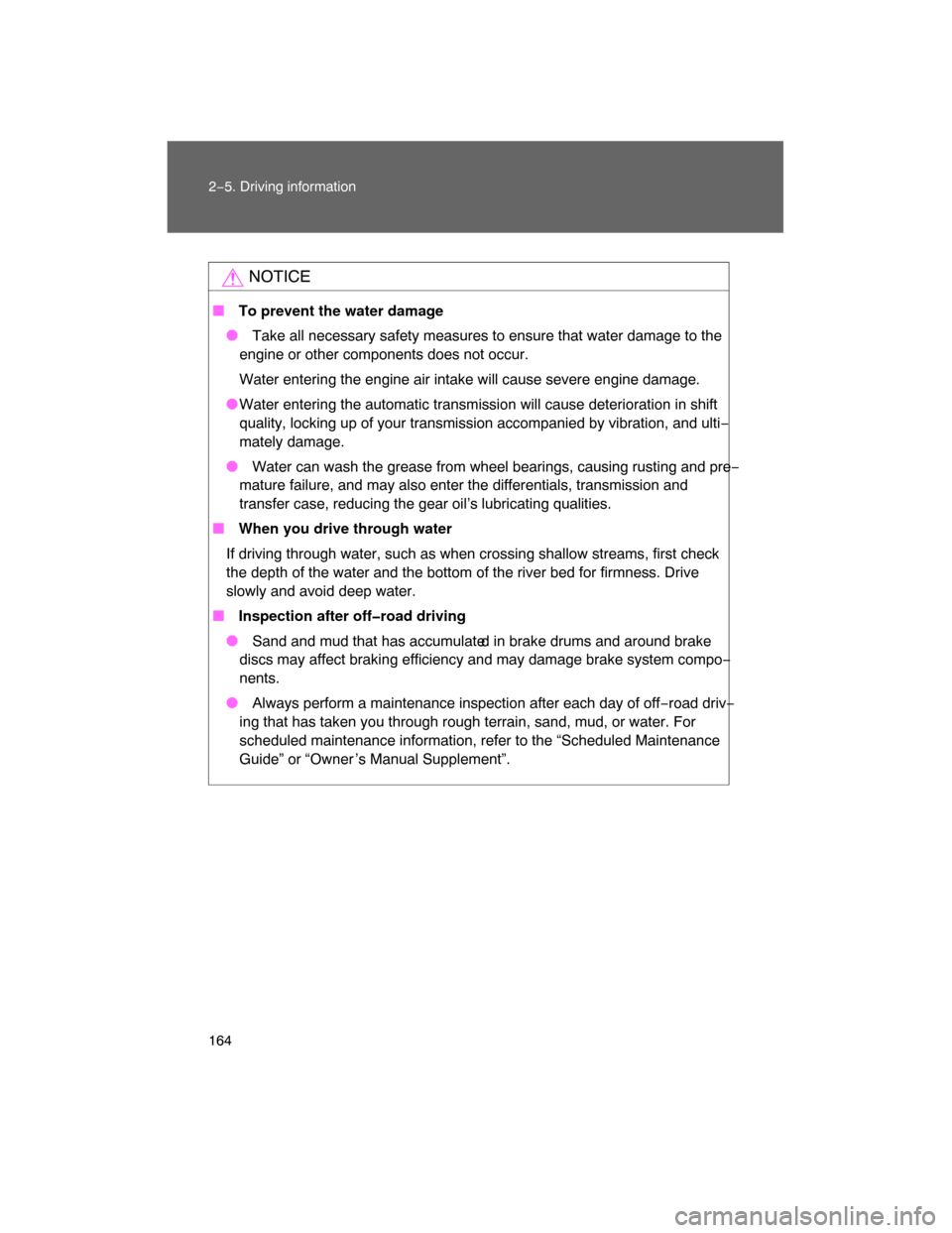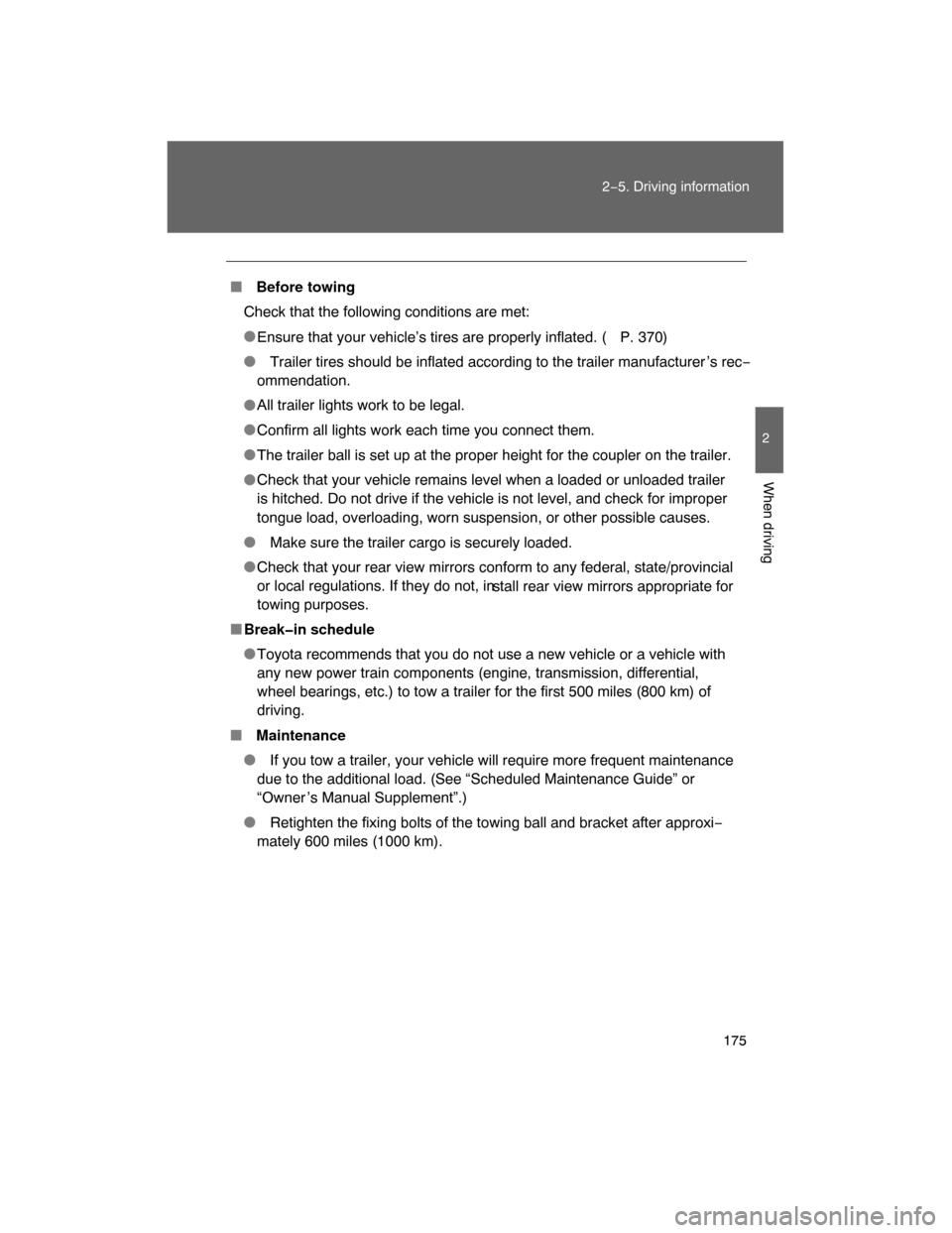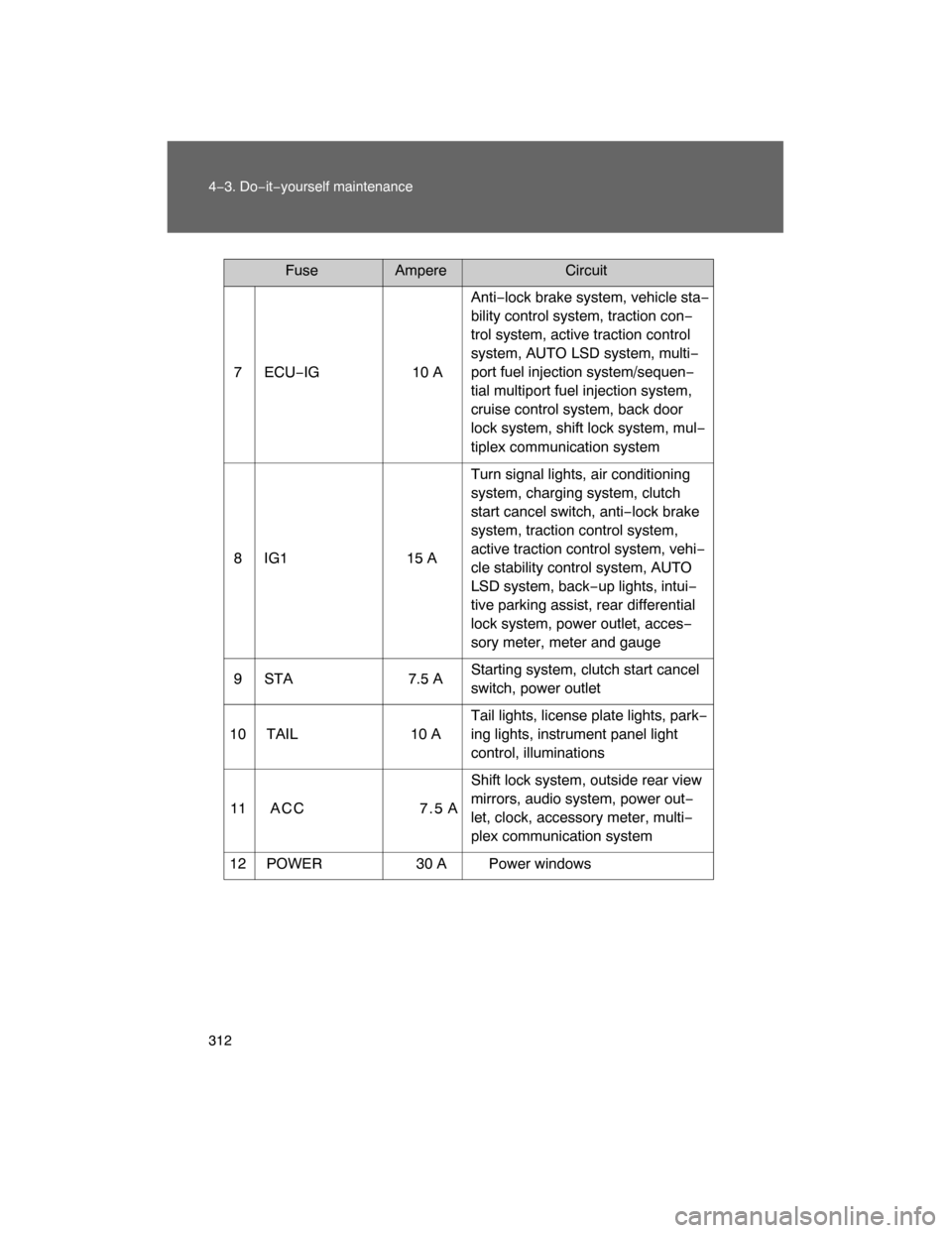Page 152 of 400
154 2−4. Using other driving systems
CAUTION
� To avoid an accident
� Do not use the rear differential lock system except when wheel spinning
occurs in a ditch or on a slippery or ragged surface. Large steering effort
and careful cornering control will be required.
� Do not lock the rear differential until the wheels have stopped spinning.
Otherwise, the vehicle may move in an unexpected direction when the dif−
ferential lock is engaged, resulting in an accident. This may also lead to
possible damage to differential lock component parts.
� Do not drive over 5 mph (8 km/h) when the differential is locked.
�
Do not keep driving with the RR DIFF LOCK switch on.
Page 155 of 400
157
2−4. Using other driving systems
2
When driving
To disable VSC
If the vehicle gets stuck in fresh snow or mud, VSC may reduce
power from the engine to the wheels. You may need to turn the sys−
tem off to enable you to rock the vehicle in order to free it.
Vehicles with rear differential lock system
Press the RR DIFF LOCK
switch.
The rear differential lock and VSC
OFF indicators should come on.
Push the switch again to turn the
system back on.
4WD models with an automatic transmission
Shift the front−wheel drive control
lever to H4 or L4.
The four−wheel drive and VSC
OFF indicators should come on.
Shift the lever to H2, turn the sys−
tem back on.
4WD models with a manual transmission
Shift the four−wheel drive control
lever to HL or LL.
The center differential lock and
VSC OFF indicators should come
on.
Shift the lever to H, turn the sys−
tem back on.
Page 162 of 400

164 2−5. Driving information
NOTICE
� To prevent the water damage
� Take all necessary safety measures to ensure that water damage to the
engine or other components does not occur.
Water entering the engine air intake will cause severe engine damage.
�Water entering the automatic transmission will cause deterioration in shift
quality, locking up of your transmission accompanied by vibration, and ulti−
mately damage.
� Water can wash the grease from wheel bearings, causing rusting and pre−
mature failure, and may also enter the differentials, transmission and
transfer case, reducing the gear oil’s lubricating qualities.
� When you drive through water
If driving through water, such as when crossing shallow streams, first check
the depth of the water and the bottom of the river bed for firmness. Drive
slowly and avoid deep water.
� Inspection after off�road driving
� Sand and mud that has accumulate
d in brake drums and around brake
discs may affect braking efficiency and may damage brake system compo−
nents.
� Always perform a maintenance inspection after each day of off−road driv−
ing that has taken you through rough terrain, sand, mud, or water. For
scheduled maintenance information, refer to the “Scheduled Maintenance
Guide” or “Owner ’s Manual Supplement”.
Page 173 of 400

175
2−5. Driving information
2
When driving
� Before towing
Check that the following conditions are met:
�
Ensure that your vehicle’s tires are properly inflated. ( P. 370)
� Trailer tires should be inflated according to the trailer manufacturer ’s rec−
ommendation.
�All trailer lights work to be legal.
�Confirm all lights work each time you connect them.
�The trailer ball is set up at the proper height for the coupler on the trailer.
�Check that your vehicle remains level when a loaded or unloaded trailer
is hitched. Do not drive if the vehicle is not level, and check for improper
tongue load, overloading, worn suspension, or other possible causes.
� Make sure the trailer cargo is securely loaded.
�Check that your rear view mirrors conform to any federal, state/provincial
or local regulations. If they do not, in
stall rear view mirrors appropriate for
towing purposes.
�Break�in schedule
�Toyota recommends that you do not use a new vehicle or a vehicle with
any new power train components (engine, transmission, differential,
wheel bearings, etc.) to tow a trailer for the first 500 miles (800 km) of
driving.
� Maintenance
� If you tow a trailer, your vehicle will require more frequent maintenance
due to the additional load. (See “Scheduled Maintenance Guide” or
“Owner ’s Manual Supplement”.)
� Retighten the fixing bolts of the towing ball and bracket after approxi−
mately 600 miles (1000 km).
Page 308 of 400

312 4−3. Do−it−yourself maintenance
7 ECU−IG 10 AAnti−lock brake system, vehicle sta−
bility control system, traction con−
trol system, active traction control
system, AUTO LSD system, multi−
port fuel injection system/sequen−
tial multiport fuel injection system,
cruise control system, back door
lock system, shift lock system, mul−
tiplex communication system
8 IG1 15 ATurn signal lights, air conditioning
system, charging system, clutch
start cancel switch, anti−lock brake
system, traction control system,
active traction control system, vehi−
cle stability control system, AUTO
LSD system, back−up lights, intui−
tive parking assist, rear differential
lock system, power outlet, acces−
sory meter, meter and gauge
9 STA 7.5 AStarting system, clutch start cancel
switch, power outlet
10 TAIL 10 ATail lights, license plate lights, park−
ing lights, instrument panel light
control, illuminations
11 A C C 7 . 5 AShift lock system, outside rear view
mirrors, audio system, power out−
let, clock, accessory meter, multi−
plex communication system
12 POWER 30 A Power windows
FuseAmpereCircuit
Page 361 of 400

367
6−1. Specifications
6
Vehicle specifications
Differential
Automatic transmission
*: The fluid capacity is the quantity of reference. If replacement is necessary,
contact your Toyota dealer.
Oil capacityFront
(4WD models)
Vehicles with a manual transmission
1.5 qt. (1.4 L, 1.2 Imp.qt.)
Vehicles with an automatic transmission
1.7 qt. (1.6 L, 1.4 Imp.qt.)
Rear
Vehicles with a rear differential lock
3.1 qt. (2.9 L, 2.6 Imp.qt.)
Vehicles without a rear differential lock
3.2 qt. (3.0 L, 2.6 Imp.qt.)
Oil type and
viscosityFront
(4WD models)Hypoid gear oil API GL−5
Vehicles with an automatic transmission
SAE75W−85
Vehicles with a manual transmission
Above 0
F (−18C): SAE90
Below 0
F (−18
C): SAE80W or 80W−90
RearHypoid gear oil API GL−5
Above 0 F (−18C): SAE90
Below 0
F (−18
C): SAE80W or 80W−90
Fluid capacity
*11.3 qt. (10.7 L, 9.4 Imp.qt.)
Fluid type Toyota Genuine ATF WS
NOTICE
� Automatic transmission fluid type
Using automatic transmission fluid other than “Toyota Genuine ATF WS”
may cause deterioration in shift quality, locking up of your transmission
accompanied by vibration, and ultimately damage the automatic
transmission of your vehicle.
Page 384 of 400
392
Abbreviation list
Abbreviation/Acronym list
ABBREVIATIONS MEANING
2WDTwo Wheel Drive
4WD Four Wheel Drive
ABS Anti−Lock Brake System
ACC Accessory
AI−SHIFT Artificial Intelligence shifting
ALR Automatic Locking Retractor
A−TRAC Active Traction Control
AUTO LSD Automatic Limited Slip Differential
CRS Child Restraint System
E/M English/U.S. Customary System and metric
ECU Electronic Control Unit
EDR Event Data Recorder
ELR Emergency Locking Retractor
GAWR Gross Axle Weight Rating
GVWR Gross Vehicle Weight Rating
I/M Emission inspection and maintenance
INT Intermittent
LED Light Emitting Diode
LT Light truck
M + S Mud + Snow
MMT Methylcy clopentadienyl Manganese Tricarbonyl
MTBE Methyl Tertiary Butyl Ether
OBD On Board Diagnostics
RES Resume
RR DIFF LOCK Rear differential lock
SRS Supplemental Restraint System
TIN Tire Identification Number
Page 386 of 400

394
Alphabetical index
Alphabetical index
A/C ............................................. 184
ABS ........................................... 156
Access doors ............................. 36
Accessory meter ...................... 130
Active traction control
system .................................... 148
Air conditioning filter............... 298
Air conditioning system
Air conditioning filter .............. 298
Manual air conditioning
system ................................ 184
Airbags
Airbag operating conditions..... 76
Airbag precautions for your
child ...................................... 80
Airbag warning light............... 332
Curtain shield airbag operating
conditions.............................. 76
Curtain shield airbag
precautions ........................... 83
Front passenger occupant
classification system ............. 85
General airbag precautions ..... 80
Locations of airbags ................ 73
Modification and disposal of
airbags .................................. 84
Proper driving posture ....... 71, 80
Side airbag operating
conditions.............................. 76
Side airbag precautions .......... 82
SRS airbags ............................ 73
Antenna..................................... 199
Anti�lock brake system
ABS warning light .................. 332
Anti−lock brake system .......... 156
Armrest ..................................... 246
Audio input ............................... 222
Audio remote controls............. 224
Audio system
Antenna ................................. 199
Audio input ............................ 222
AUX adapter.......................... 222
CD player .............................. 200MP3/WMA disc ..................... 208
Optimal use ........................... 217
Portable music player ........... 222
Radio..................................... 194
Type ...................................... 191
AUTO LSD system ................... 150
Automatic light off system...... 132
Automatic limited slip
differential .............................. 150
Automatic transmission
Automatic transmission ......... 117
If the shift lever cannot be
shifted from P ..................... 351
AUX adapter ............................. 222
Auxiliary box .................... 228, 234
Back door ................................... 38
Back door lock ........................... 38
Back�up lights
Replacing light bulbs ............. 318
Wattage................................. 371
Back window .............................. 41
Battery
Charging system warning
light ..................................... 332
Checking ............................... 283
If the vehicle battery is
discharged .......................... 353
Preparing and checking
before winter ....................... 169
Bottle holders................... 228, 233
Brake assist.............................. 156
Brakes
Brake system warning
buzzer ................. 149, 151, 158
Brake system warning light ... 331
Fluid ...................................... 280
Parking brake ........................ 122
Break�in tips............................. 106
A
B